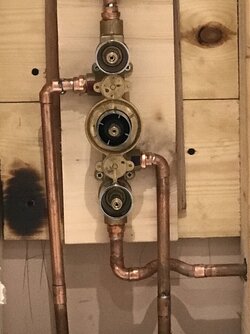Profpointy
Legendary Member
We had a similar issue with ours. Ended up replacing the whole unit. Our local and excellent pro plumbing supplies said if I brought in the the thermostat bit they'd give a go identifying it, (there are hundreds os slightly different parts) but the practicalities meant I'd have to have the water off for an extended period to do so. Managed to get a whole new unit (good make) cheap off the 'bay. The job escalated and the stud wall ended up being replaced re-tanked and the whole lot retiled. Still, it seems to have cured my basement damp.
In retrospect, given the total rebuild, I should have replaced the hidden-in-wall valve with something accessible like your unit, but hey ho; likely someone else's problem as it should last long enough for us
Posted before in the DiY thread but here's the job






In retrospect, given the total rebuild, I should have replaced the hidden-in-wall valve with something accessible like your unit, but hey ho; likely someone else's problem as it should last long enough for us
Posted before in the DiY thread but here's the job

Last edited:


